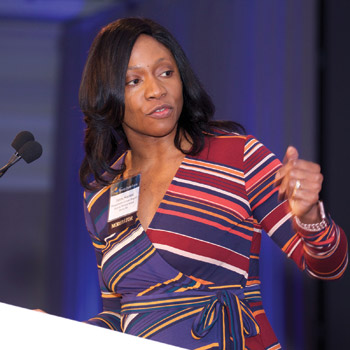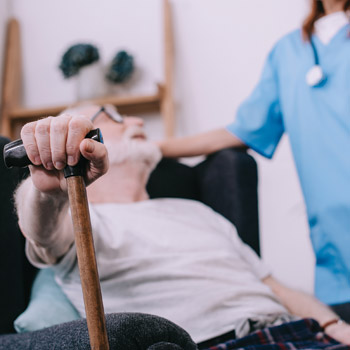What does a doctor look like?
Black doctors have responded to medical emergencies in public spaces, only to have their credentials questioned. One physician answers questions on her experience, and reflects on ways to improve the public perception of who might be a doctor.
Fatima Cody Stanford, MD, MPH, MPA, FACP, is widely regarded for her expertise as an obesity medicine subspecialist. But in October 2018, the public came to know her for another reason.
While on a plane flying from Indianapolis to Boston, where Dr. Stanford is a physician at Massachusetts General Hospital and an instructor at Harvard Medical School, the woman seated next to her, who initially appeared nervous, began to show signs of distress. She started kicking the seat in front of her and pushing her chair back into the seat behind her. “You couldn't tell if she was convulsing, if she was hyperventilating,” Dr. Stanford said. “This happened pretty quickly, so since I'm immediately to her right, obviously I'm going to respond.”

As Dr. Stanford, who is black, began to address the patient, a flight attendant approached and asked if she was a doctor. She replied that she was and, unprompted, produced a pocket version of her medical license, which the attendant briefly viewed before walking away. As Dr. Stanford continued to focus on getting the patient to breathe normally, a second flight attendant came by, asked to see the license, and viewed it for a longer duration before walking away.
“At this point, I'm realizing that this woman is having what appears to be, to me, a panic attack, and I really need to do what I can to get her calm,” Dr. Stanford said, adding that the two switched positions so the patient could be in the aisle seat. “She's responding and able to move, but still quite on edge.”
Then the two attendants returned and, now adjacent to the patient, further questioned Dr. Stanford's medical credentials. The first asked, “Are you a head doctor?” but Dr. Stanford wasn't sure what she meant at the time. (Now, she believes they meant a psychologist, psychiatrist, or therapist.) The attendant then asked, “Are you an MD?” Dr. Stanford was confused because she had already shown the attendant her medical license from the Commonwealth of Massachusetts, which clearly shows that she has an MD. Finally, the second attendant asked if the license was really hers. Dr. Stanford replied, “Why would I be carrying someone else's medical license?” After this exchange, the attendants left her alone for the duration of the flight.
Dr. Stanford recently spoke with ACP Internist about the experience, its aftermath, and what a doctor really looks like.
Q: What happened for the rest of the flight?
A: My goal was to focus on the patient because she still seemed to be quite rigid and anxious. Unfortunately, they never asked her (the patient) once during the entire two-plus-hour flight how she was doing.
I realized that the only thing that really kept her calm was just to listen to me talk, so I needed to come up with content. Since I was in meetings that whole day, I had not been able to respond to my emails, so I had about 130, and I literally just went through them with her. … I did get a chance to find out who she was. As a young woman completing her training to teach English as a second language in France, her native country, she spends most of her time in Europe. She comes to visit a friend in Indianapolis every few years, but the trip does cause her some distress. She said smaller planes make her very nervous, that she does a bit better on the bigger planes that come over the Atlantic.
And then, right as we're about to make our final descent into Boston, the second flight attendant, the one that asked me if this was really my license, comes by and she says, “I just wanted to let you know we don't need to see your license again because it seems like you did a good job.” I just kind of looked at her with a bewildered look. Then we land, and as we're getting off, the same flight attendant that just told me I did a “good job” says, “Well, are you sure she's OK?” and I said, “Yes, I'm sure she's OK.”
Q: What happened when you got home, after you processed this experience?
A: I got home, talked to my husband, and basically told him the story, and he said, “You should tweet it.” And I was like, “OK, that kind of makes sense.” I landed about 8 p.m., and I tweeted out about the story about 10 p.m. … The next morning, I see this email from Delta [Air Lines] saying something like, “We've heard that there was concern on your flight.” I think I tried calling back the person, the person's not available, and I fly out at 4 p.m. that day to Pittsburgh to give the keynote for the Academy of Nutrition and Dietetics. The only conversation I ever had with Delta was right before I boarded this flight into Pittsburgh on American [Airlines].
Basically, the summary of what happened was they said, No. 1, the flight attendants wanted to be sure I wasn't a therapist. I'm not sure where that came from; I never acknowledged myself to be a therapist. That's not my role. No. 2, they're sorry for any misunderstanding that occurred and are working on this at the highest levels of the company. No. 3, they wanted to thank me for being a Delta SkyMiles member. And No. 4, they wanted me to fly Delta again soon. That has been the sum total of my direct communications with Delta to date. Of course, after that, basically every major broadcast and print outlet picked it up, from the New York Times to Fortune to CNN to the U.K. Daily Mail.
Q: In 2016, a similar incident happened to another black female physician aboard a Delta flight. Did this feel like déjà vu?
A: Just two weeks prior [to the incident], the Massachusetts Medical Society held a conference on gender and bias in medicine, and I helped coordinate it. We had flown in Dr. Tamika Cross, who was the woman to which this had happened back in 2016. She was a resident physician at the time, and she did not have access to her medical license. She had been on a Delta Air Lines flight and was not allowed to render any care. They didn't believe she was a physician.
Since that time, we've stayed in contact … and she came as our keynote speaker, and I interviewed her on stage about her experience on Delta Air Lines. That was Oct. 19, 2018, and this happened to me on Oct. 30, 2018. I knew exactly what was going on when it was happening.
Q: What does a physician look like?
A: I think that when people think about what a doctor looks like, they think of a white male, usually a little bit more senior, meaning maybe gray hairs or maybe no hair. If you do a Google search, that's typically what will pop up. You're not going to see a black woman in a Badgley Mischka dress with six-inch heels on, which would be my picture. The visual that's been conveyed to people throughout their life is a visual that doesn't reflect what I look like.
Q: Why do you carry your medical license with you?
A: I don't blend, and I don't intend to blend to conform to any standards. That's why I have this kind of defense mechanism of making sure my license is on me. People are shocked that I have my license. They're like, “Really? You carry your license? Who does that?” But a lot of people that say that to me are people that don't look like me. The only reason that I decided to carry it was because after that incident happened to Dr. Cross, who became my friend, I was like, “Wait a minute, I probably don't look like what people would presume I should look like to be a physician.”
Q: Where do we go from here?
A: Interestingly enough, just in Congress recently, there was a bill that passed that specifically speaks to issues regarding diversity on commercial airlines, the Federal Aviation Administration Reauthorization Act of 2018. [Signed into law in October 2018, the reauthorization bill includes new provisions about training policies regarding racial, ethnic, and religious nondiscrimination.] I had no idea that there was any type of bill that had recently passed that governs what should be done, but this [incident] speaks volumes to what's not being done. I think that there's a lot of work that needs to be done.
Editor's Note: The Delta Air Lines flight mentioned in this story was operated by Republic Airline, a Delta Connection carrier. Both airline companies provided statements to news outlets in coverage of Dr. Stanford's tweets saying in part that they were sorry for any misunderstanding.





